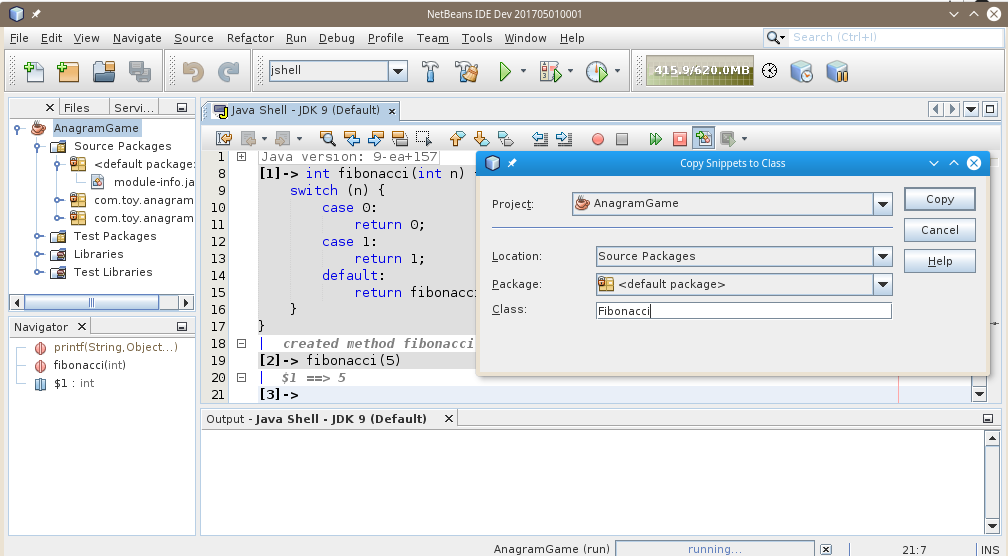Note: NetBeans 9 is a work in progress and not released yet. Below is a list of features it will have.
NetBeans 9 runtime platforms are JDK8, JDK9, JDK10. JDK9 and JDK10 can be used as Projects Java Platform even NetBeans itself is running on top of JDK8.
JDK 9 – Java Platform Module System Support
Java Application project extensions
NetBeans 9 provides features to support JPMS (Jigsaw). Modulepath was added as a crucial paradigm to NetBeans in addition to Classpath.
Standard NetBeans Java SE Project (Ant) can be a single JDK9 module simply by adding module-info.java into default package.
module-info.java supports code completion,...
Full Edit - Compile - Debug and Profile cycle is supported. Java SE projects with JDK9 module can define dependencies on themselves using Project Libraries customizer dialog and by defining appropriate exports and requires in their module-info.java files.
This picture shows dependency of 1 project on 2 other projects. The mix of projects with module-info.java or without it is allowed. Modulepath and Classpath are supported.
It is possible to show module dependencies graph for each module-info.java.
Java SE Project allows to develop and store JUnit tests:
- inside same module. In this case no changes to develop and execute tests are needed in main module-info.java
- in its own JUnit JDK9 module (own module-info.java). In this case main module-info.java exports the tested packages and tests module-info. java requires application module and JUnit...
The picture below shows the structure of JavaSE projects with JUnit tests in same module and with own module:
Java Modular Application Project type
New project called Java Modular project was added. This allows to develop several JDK9 modules in one NetBeans project (Ant based). Advantage of this project over several Java SE project each containing 1 module is that dependencies are simply managed by declaring appropriate exports and requires in module-info.java files and all modules in the project are being compiled at once.
Following picture depicts how Java Modular Project can look like.
Other Java 9 features
Every JavaSE (with module-info.java) or Java Modular App project can be packaged into JLink image allowing seamless distribution of app and required modules.
HTML5 tags are supported in NetBeans editor and HTML5 JavaDoc can be generated using projects Properties | Documenting customizer.
JDK 9 – JavaShell
Java Shell is a tool in JDK9 defined in JEP 222 to introduce REPL (read-eval-print-loop) capabilities to Java. NetBeans provides integrated console-like UI for the Java Shell, leveraing NetBeans editor capabilites. NetBeans can support the tool with the user project configuration, so the Java Shell is set up to work with project classes and libraries.
NetBeans IDE greatly extends capabilities of the commandline tool. NetBeans can execute the shell as an agent, similar to debugging agent, on the debugged or run application - currently only J2SE applications are supported, both Ant and Maven-based.
The developer can use Java Shell as an agent within the running process (even without a debugger), to inspect internal state, alter it and trigger events.
Snippets written in JShell can be redefined and tested, even against a running code. When prototype is ready, it can be saved to a regular java source file and integrated with the project.
Java Profiler
Profiler Results Improvements
Actions to expand and collapse nodes have been added to the profiler treetable results. For example, the Expand Topmost Path action makes it very easy to select the performance bottleneck in the EDT. For Methods results the Show Only This Thread and Hide This Thread actions have been added.
Resizable Popups
The popups used to configure the profiler or filter the results can now be resized, which makes it easier to handle long class or method names.














